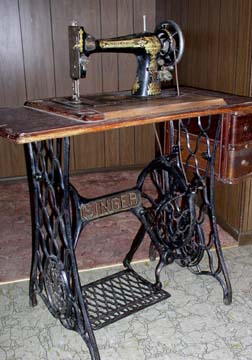
long-bobbin Singer (artifact #27)

The shuttle mechanism, and the long bobbin it uses, was the basis of Singer's first patent and revolutionized the sewing industry world wide. This is an early long-bobbin machine. It is distinguished from the later round-bobbin and shuttle by its two inch-long bullet-shaped shuttle and long, skinny bobbin. An early model is identified externally by the wooden connecting rod (treadle to drive wheel) with adjustable wooden bearing surface, working directly on the iron crank throws. Changes on later models included a smaller hand wheel, steel connecting rod with swivel joint at the treadle end and a ball bearing on the drive wheel, and for the new shuttle, a bobbin winder for the round-style bobbin. Most, if not all, newer sewing heads have a cast-in mount for an electric motor adjacent (just below) the hand wheel's pulley.
The engineering and manufacturing techniques are the best. Cast-Iron undercarriage is superb. Singer cabinets are junk, and this one is incomplete. The left-hand drawers are missing. The hinged work surface, which serves as a top when the machine head is folded underneath, is gone, although the hinge mortises are visible in this picture. And originally there was an enclosure, a dust-bunny trap, hanging underneath to hide the sewing head when it is stowed.
A few "baby Singers", about two-thirds scale model, were manufactured. Several sizes of bigger machines were sold for use in industry and saddle shops. The largest of these are driven from overhead flat belts and pulleys. Charley reports that Grandmother Doyle used a "vertical feed" Singer.